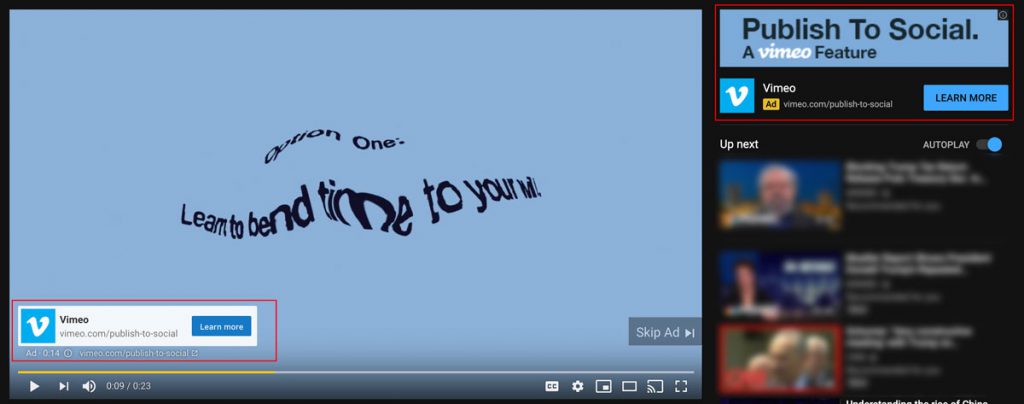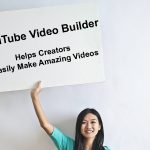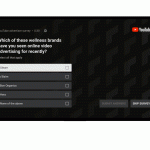 Membership TodaySign Up Now
Membership TodaySign Up NowThis post will break down the different types of YouTube Ads. Whether you’re creating your first ad or are trying to improve the results of your advertising strategy, this guide will help you determine which type of ad will work best for your campaign goals.
YouTube Ads are referred to as TrueView Ads and are set up to only charge advertisers when their ads are viewed or clicked on.
Each type of ad has its own characteristics, specifications and use cases. You might consider each one while developing your strategy, and which format is going to be most effective in achieving your objectives.
In-Stream Ads
One of the most common ads on YouTube are In-stream ads. They will show before, during or after a partner’s video plays.
In-stream ads are charged per view. Users are given the option to skip your ad after five seconds. You are only charged for these videos if the users watch to the end or more than 30 seconds, whichever is greater, just in case the video is less than 30 seconds.
One of our favorite companies that create highly engaging in-stream ads is the now infamous Squatty Potty by the Harmon Brothers. Have a look at some of their ads for examples of ads people don’t want to skip. We have links below this video in the Resources section.
At TubeSift we find instream skippable ads to be the most effective because you only pay when the user is truly interested in your ad and watches more than 30 seconds or until the end.
Compelling users to continue watching your ad past the five second mark when they’re allowed to skip is challenging. You can learn more about In-Stream Ads Best Practices in our blog post linked below.
Video Discovery Ads
Video Discovery ads can show up in YouTube search results or as recommended videos on the right hand side of the screen when someone is watching a video. There are a number of ways you can target with these videos but we find that Keyword targeting usually works the best for YouTube Search and Placements work best on the related videos.
When a user clicks the video thumbnail, they are taken to the video watch page and can watch the video.
Advertisers only pay for a view when the viewer clicks on the thumbnail and chooses to watch the video.
There’s no time limit for Discovery ads since the user must choose to watch it.
This type of ad works well for sending users to a content post like how-to videos or product demonstrations and can also drive traffic to your channel.
You can use these types of ads to drive traffic by placing links in the description or by using cards.
Non-Skippable In-Stream Ads
This video ad streams prior to a video but advertisers can also choose to play the ad in the middle or end of a video that is at least ten minutes in length. These ads will run for 15 seconds. These videos do not allow viewers to skip until the whole ad has played.
You will know a non- skippable ad video when you see the message “Video will Play After Ad” where you normally see the “Skip Video” button.
YouTube charges non-skippable ads by CPM, which means cost-per-thousand impressions. An impression represents every time an ad is displayed to a user. The advertisers set the average amount they’re willing to pay for every thousand times their ad is shown. From the target CPM the advertiser sets, YouTube’s algorithm will optimize bids to help get as many impressions as possible. Some may cost more or less than your target price.
Bumper Ads
Bumper ads are a short-form non-skippable video that plays for just six seconds before a regular video. They are a popular option because they are easier to produce than longer videos, and users are forced to watch in entirety.
It might seem counter-intuitive that six seconds would be sufficient to get your user’s attention, but a Google report suggests that out of 300 bumper ad campaigns, 90% of them led to an increase in ad recall. This makes bumper ads a great choice for short, memorable messages, promoting brand awareness or reminding viewers about your brand and its value.
Companion Banner Ads
Companion banner’s aren’t technically a type of ad but they accompany an In-Stream ad. These banners give the advertiser extra real estate on YouTube and let the advertiser combine a static visual image to go with their video ad. They are displayed in the top right side of the user’s screen on desktop and contain the same call to action buttons that are shown during the video ad.
These do not show up on mobile devices.

Display Banners
In addition, you can also overlay display banners on YouTube videos through the display network on the Google Ads platform. Display Banners are the rectangular text boxes with an associated image that you see pop-up in the bottom middle of the video while you’re watching it. Advertisers can place these on any monetized video. When users click the ad they will be taken to a landing page, your website, blog, video, or whatever the advertiser wants. Banner ads can be a great alternative or supplement to a broader advertising campaign because they can drive calls to action while a user is watching a video.
To easily deploy banner ads across targeted channels, TubeSift has a banner design studio that will help you create and deploy Banner Ads.
Whichever ad types will benefit your business and marketing strategy the most, YouTube is by far the highest viewed platform for video ads in the world. Check out our blog post Why Advertise on YouTube? to learn more.
One of the most effective ad types we use at TubeSift are In-Stream ads. Our clients and ourselves have been able to consistently generate leads and drive sales using these types of ads because you’re only charged if a viewer watches a portion of the ad. This way you can get the most cost effective placements and only pay for viewers who are truly interested in your ad.
To learn best practices for each ad type, check out our other TubeSift blog posts breaking down best practices for each ad type. You can also go to Google’s support page to view the ad type specs as well as Google Ads Help page to review the types of video ads covered in this post. Both of these are linked below in the Resources section.
Also be sure to click the link below to download your free Video Ads Checklist that will walk you through the ads process from beginning to end.
For more on how to advertise to your ideal audience with YouTube Ads and run highly effective video campaigns, follow us on social media and follow this blog for regularly posted content.
 Membership TodaySign Up Now
Membership TodaySign Up NowSources/Resources:
-For YouTube’s breakdown of the ad type specs, check them out on Google’s support page on YouTube Advertising Formats
-You can check out Google Ad Help’s breakdown of their video types on their About Ad Formats
-View the Harmon Bros. Squatty Potty Ad for an example of ads people don’t want to skip. You can also browse their YouTube channel for more great ads people, like Poo Pouri!
-You can check out ThinkwithGoogle’s breakdown of TrueView ads as well
-Find info and stats on Bumper Ads and brand recall here: ThinkwithGoogle-Bumper Ads
– Non-skippable YouTube Ads Tutorial on YouTube by Daily Marketing Journal
– Check out YouTube’s Masthead for a breakdown of the ad specifications covered in this video



Comments are closed.